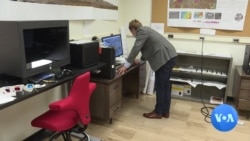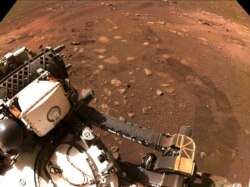Geophysical sciences professor Edwin Kite pores over a steady stream of data and images originating from U.S. and Chinese rovers and crafts simultaneously exploring Mars.
"I am interested in solar system and exoplanet habitability,” Kite explained to VOA from his University of Chicago laboratory. His field of study has traditionally been accomplished using telescopes and analyzing meteors in addition to the few moon rocks returned to Earth by U.S. astronauts who landed there in the 1960s and 70s.
But today’s on-the-ground missions exploring Mars are helping him and his colleagues obtain a more direct and complete understanding of the red planet.
“You can quickly go through a loop of making a discovery, forming a hypothesis based on that discovery and sending a new spacecraft to test it,” Kite told VOA. “We’ve only scratched the surface of what there is to discover. We don’t know which country’s investigation is going to stumble over something that unlocks the next stage of exploration. The more countries doing that exploration, the better, for everyone.”
Testifying remotely at a recent U.S. congressional hearing, NASA Administrator Bill Nelson, a former astronaut and former U.S. senator from Florida, signaled alarm at the recent success of the Chinese space program, which he said wasn’t confined to Mars exploration.
“They want to send three big landers to the south pole of the moon. And that’s where the water is,” he said. “And we are still a year or two away from a much smaller lander going there.”
Artemis program
Nelson is urging lawmakers to support NASA’s Artemis program, which plans to return humans – including the first woman – to the moon, with Mars as an eventual destination.
Nelson said China is on a similar path.
“I think that’s adding a new element as to whether or not we want to get serious and get a lot of activity going on landing humans back on the surface of the moon,” he said.
“China is gaining rapidly on the U.S., and the Europeans are also in this space race,” said Rocky Kolb, a professor of astronomy and astrophysics at the University of Chicago who believes a new space race could be mutually beneficial. “Competition brings out the best in everyone. It pushes people, and there’s a lot to explore in space.”
Kolb would like to see the U.S. and Chinese space programs collaborate as well as compete.
“I think it would be great in the future if the U.S. could cooperate with China in the same way that now we cooperate with the European Space Agency," he said. "It adds a lot to the table. There’s a lot of talent in China that we could make use of and a lot of resources in China, and they have a lot of money to explore space. And I think this is something that mankind should do together.”
But both Kite and Kolb acknowledged there was a limit to how much cooperation could realistically occur between the United States and China.
“The technology involved in the peaceful exploration of space can also be transported to military uses,” Kolb told VOA.
Different ways to cooperate
Kite said that while there are legal and political barriers that prevent NASA and the Chinese space agency from working together, “those don’t apply to non-NASA-funded work by academic institutions” such as his own.
For now, Kite, Kolb and the global scientific community continue to examine tantalizing data and images relayed from Mars that could yield clues about the origin of life on Earth. Kolb noted that human curiosity and the thirst for knowledge transcend national borders.
“Mars is a big planet and there are many places to explore and many unanswered questions," he said. "Every rover is doing something different, and the total of what we learn is important. There is only one Mars. It doesn’t belong to the U.S. and it doesn’t belong to China."












